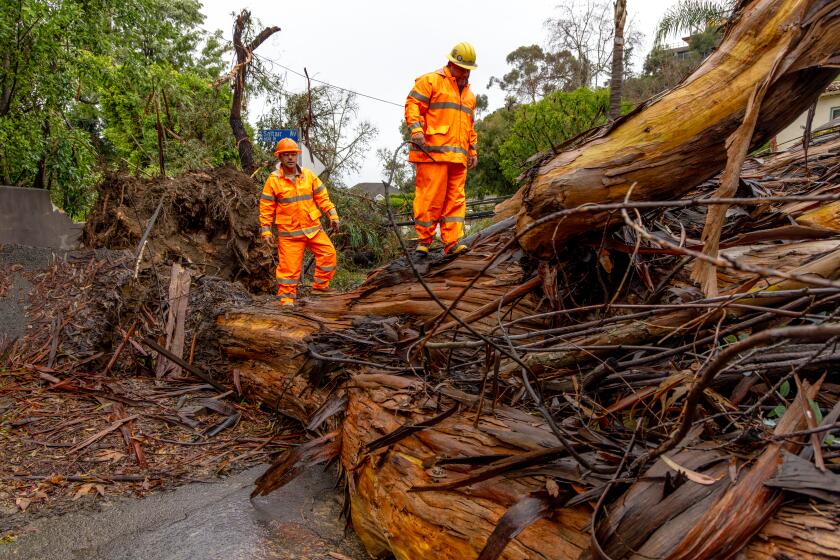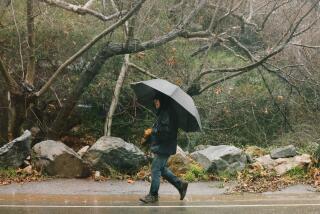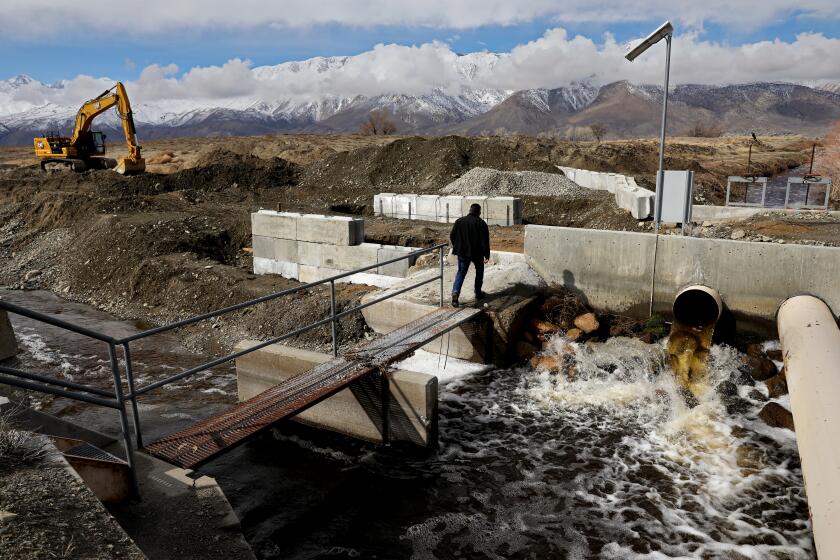
Heavy rains pummeling Southern California for the last several days are forcing millions of gallons of raw sewage to spew from sewer connections across Los Angeles County and flow into coastal waters off Long Beach and San Pedro, according to health and sanitation officials.
As communities throughout the Los Angeles Basin cope with mudflows, power outages and flooding, county sanitation crews have struggled to contain multiple sewage spills that have sent waste flowing down major streets and into storm drain systems leading to environmentally sensitive Cabrillo Beach and the Port of Los Angeles, among other locations.
“The problem has been an extremely unusual amount of rain water leaking into the county sewer system causing more flow than some sewer pipelines can handle,” said Bryan Langpap, a spokesman for the L.A. County Sanitation District.
Los Angeles County flood control network withstands punishing rains -- for now
On Tuesday, sewage escaped through manhole covers near the Port of Long Beach and in Whittier, about 20 miles from downtown Los Angeles. County sanitation officials were still trying to quantify the amount of sewage that leaked into storm drains before the spill was contained.
On Monday, a far larger spill occurred in the unincorporated community of Rancho Dominguez, about 10 miles north of Long Beach. An estimated 8 million gallons overflowed manholes and streamed into storm drains that empty into the Dominguez Channel, which terminates at Cabrillo Beach, Langpap said.
“We normally get a handful of these kinds of spills a year,” he added. “But we’ve had nine powerful back-to-back storms rip through the county over the past week alone. Unfortunately, when it’s raining cats and dogs, there’s not a lot we can do but wait it out.”
When the storm dumped more than 4 inches of rain in the L.A. area by Monday, he said, some stretches of the sanitation district’s 1,400 miles of sewer lines were backed up with water pouring through openings in manholes.
When the slow-moving storm system finally moves out of Southern California on Wednesday, sanitation crews will rush in to mop up any remaining sewage puddled on the streets.
County health officials said they were testing water off Cabrillo Beach for chemicals, debris, trash and coliform bacteria, which survive about two days in saltwater and can cause diarrhea and other intestinal problems.
The Los Angeles Department of Public Health has issued an ocean water closure that will remain in effect until it receives sampling results indicating that bacteria levels meet health standards.
Separately, county health officials advise beach users to avoid all water contact, especially near discharging storm drains, creeks and rivers due to potentially higher levels of bacteria.
“Individuals who enter the water in these areas could become ill,” the health department said. “Rain advisories remain in effect for 72 hours after the rainfall ends.”
The storm fed off of unusually warm waters as it grew. It also reached “bomb cyclone” status as it neared California.
Periodic spills of untreated wastewater are nothing new in the county’s vast, complex network of flood control channels and storm drains that dump a witch’s brew of debris, bacteria, pesticides and heavy metals from industrial permit holders and municipalities into harbor waters.
But the problem has worsened because of skyrocketing growth in a region of 10 million people combined with whiplashing weather extremes.
To resolve discharge violations from 14 separate spills including a massive overflow that released 8.5 million gallons of untreated wastewater into the Dominguez Channel in 2021, the Los Angeles County Sanitation Districts’ Joint Outfall Collection System on Tuesday agreed to pay $6 million imposed by the Los Angeles Regional Water Quality Control Board.
The incidents, which took place between 2018 and 2022, largely resulted from operational and structural failures. But the most egregious violation occurred in Carson during a rainstorm in December 2021, when a mainline ruptured, sending raw sewage into a residential neighborhood, down storm drains and into the Dominguez Channel before emptying into the Pacific Ocean.
The incidents “illustrate why replacing and modernizing infrastructure must be a priority for sewer owners and operators,” said Los Angeles Water Board Chair Norma Camacho.
Toward a more sustainable California
Get Boiling Point, our newsletter exploring climate change, energy and the environment, and become part of the conversation — and the solution.
You may occasionally receive promotional content from the Los Angeles Times.










